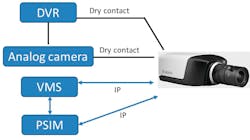Mitigating active shooter situations at the K-12 level doesn't have to be expensive
A rash of recent school shootings has renewed the call for better security. The problem is that K-12 schools often don’t have the budget to match their growing security needs. But there are steps every district can take now to make schools safer, and they don’t need to spend lot of money to do it.
Every K-12 school in the U.S. should have the $400 solution, which is outlined below, in their reception area. This is a simple solution that is still based on cutting-edge intelligent technology. Having this $400 solution could save a life, if not dozens.
Detection, Decision and Notification
First, we have to realize that there is no definitive way to entirely stop school shootings. We must concentrate, instead, on detecting and acting on a situation once it happens.
It doesn’t matter how much security a school puts on fences, doors and lobbies. These measures may prevent some people from getting in, but it can’t stop everyone. Someone intent on doing harm can easily tailgate a person with authorized entry through a controlled door. Imagine – a parent is buzzed into a school, and the bad guy walks in behind, draws a gun and starts shooting.
In active shooter situations, every second matters; and while it may not be possible to stop every crazed gunman from entering a school, technology can provide instant situational awareness making it possible to take immediate, potentially-life saving action.
The kneejerk reaction might be to consider a gunshot detector, but for cash-strapped schools, this would be cost prohibitive. Typically deployed in city centers, these detection devices use sophisticated triangulation to pinpoint the direction of a gunshot, but cost from $50,000 to $100,000 each.
A school’s needs are much more modest. In an active shooter situation, it’s not necessary to know precisely what direction a gunshot is coming from. But officials would want to be instantly alerted if there’s a very loud sound, suggestive of screaming or gun shots.
Fortunately, there is a cost effective way for cash-strapped schools to accomplish this.
For several years many camera manufacturers have been adding more intelligence to their edge devices. Many are now configurable, like a mini self-contained computer, and can sense loud sounds through built-in microphones, ignore certain frequencies, make decisions and then notify those who need to know.
In an active shooter situation, there are three basic capabilities required:
- Detection (loud noise is detected)
- Decision (determination that it is potentially an active shooter situation)
- Notification (immediately alert the proper authorities, administrators and other stakeholders).
Let’s look at how this can be accomplished using a typical $400 IP camera. Remember, the concept is very simple and so it should be doable with many models and brands. In this case, it was tested on one IP camera model and brand.
Detection
Many IP cameras have a built-in microphone (or alternatively a school can use an external mic via the line-in port). The idea is to use this microphone for detection. Audio detection can be configured in three ways to ensure the highest probability of detecting an active shooter situation.
- Threshold: this is the level above which the alarm will trigger, so it should be set quite high. It is easy to test – just have someone talk, shout and then scream and decide at which point you want an alarm to be generated. This will minimize false alarms. I also recommend that schools team up with their local police, who should be able to test the system using blanks.
- Sensitivity: this is how quickly the camera responds to changes in the sound environment, so it should be set fairly high. You want the alarm to trigger the moment the shot is heard, and not have to wait for a long period of high noise before the alarm trips.
- Tonal range: certain groups of frequencies can be selected or deselected to eliminate false alarms. To detect both gun shots and screaming, all frequencies should be activated. If it is just for gun shots, I recommend staying in the lower range -- 300Hz – 1 kHz.
Decision
Now that the audio input has been configured to detect a very loud sound, a decision must be made on how to proceed. To accomplish this, the camera can be programmed using simple scripting language. A few lines of code is all that is needed to trip a relay, send an email, execute an HTTP command or send an SNMP trap for example. Through the power of scripting, a camera can even be programmed to do a combination of things, as well as avoid sending multiple alarms for the same event.
Notification
Most school administrators might not know this, but with proper configuration, you can also program intelligent cameras to send notifications to people, or even other systems, in the event of an emergency. The best option will depend on the circumstances; for example, whether there’s an existing CCTV system, intrusion system or access control system, or an existing contract with a central monitoring station.
District Office
A simple solution is to configure the camera to connect to a video decoder and small monitor located at the front desk of the district office. This desk is invariably manned during school hours, and if the decoder is wired to set off a loud buzzer or siren, then the front desk staff would hear the alarm and glance at the monitor, which would be showing the appropriate camera. The staffer would then perform video and/or audio verification and initiate the standard procedure, which would probably include announcing a lock down over the school’s PA system, in addition to calling 911.
Notification via Relay Output
Another approach is to have the camera trigger its own relay output. The camera can be wired to anything that has a dry-contact alarm input, which in turn generates alerts that are monitored. Even the oldest DVRs (Digital Video Recorders) can receive alarm inputs from cameras, and can be propagated to users/administrators of the DVR system. The beauty of this approach is that no IP network is necessary, because the IP camera is simply used as an intelligent microphone. Since the camera has a slot for a local SD card, video and audio can even be recorded for potential forensic analysis.
If the IP camera is located far from the DVR, the relay output of the camera could be connected to the alarm input of another nearby existing analog camera, which is then wired to the DVR. This approach eliminates the need to rewire cameras.
Invariably video for K-12 schools is not monitored live. It’s most often used for forensic purposes. That’s why the notification aspect is so important. Administrators and authorities need to know when something bad is happening, not just address it after the fact. If a school district employs a DVR system, they can also configure it to send emails or text alarms.
Another method of notification would involve using the IP camera’s relay to trigger a dry contact input on an intrusion panel, or burglar alarm system, which can be monitored by a central station for example.
Notification via Email, SNMP or HTTP
Yet another method of alerting is to have the IP camera initiate the notification itself. If the IP camera is on the network, it can be configured to immediately send an email to a pre-specified distribution list. This list could include school district staff, administrators and law enforcement personnel. A school district’s IT department can even develop an email server rule that ‘listens’ for alarms and then launches a sequence of events including; for example:
- Mass notification: Through direct integration to a mass notification system many people could be instantly notified using a plethora of communication mechanisms (email, text, phone, etc.)
- Classroom notification: IT may have access to broadcast features that allow them to send a message to every school laptop and/or smart board, instructing each class to take precautionary measures including lock the door, draw the door window blinds, turn off the lights, take cover and stay silent.
Notification via VMS
The IP camera can directly notify the school’s Video Management System via IP as long as the VMS is compatible with the camera. This direct compatibility has recently been made possible by the introduction of the ONVIF video standard. An additional benefit of this approach is that the video can be recorded centrally as well as at the edge, which means redundant video recording. The advantage of notifying the VMS is that VMSs typically have powerful notification methods.
Notification via Collaborative PSIM
The gold standard for managing incidents is a Physical Security Information Management (PSIM) system. A PSIM system uses cross-sensor correlation (e.g. tying together a variety of sensors and systems such as mics, panic alarms, fire alarms, access control, maps, video, etc.) to provide immediate situational awareness of what is happening where, along with automated Standard Operating Procedures (SOPs) to step responders through pre-defined response plans. PSIM systems also streamline incident resolution by enhancing collaboration among various stakeholders during high stakes events, such as active shooter situations. Beyond alerts, PSIM ensures that stakeholders are working off of the same common operating picture and following the same pre-defined standard operating procedures. Administrators, command center operators and field personnel can also share video, task lists and other information. It also provides much more robust mass notification capabilities.
While a PSIM solution is generally cost-prohibitive for a single school, it can be a cost-effective solution when shared by many schools within a large city school district, or even among multiple districts in a county, state or region.
The bottom line is – schools can’t entirely eliminate the risk of active shooter situations, but they can improve their detection, decision-making, and response. This can be done through a multitude of methods ranging from intelligent edge devices to regionalized, collaborative PSIM.
In active shooter situations, time is everything. The average active shooter incident lasts about 12 minutes. Forty-three percent of the time, the crime is over before police even arrive. In cases where the police arrive while the incident is in progress, the shooter often stops as soon as he hears or sees law enforcement. Schools need to detect incidents as quickly as possible and take action immediately, locking down the school and notifying authorities.
For cash-strapped school districts, it’s good to know that even if the chance of encountering an active shooter situation is small, the right combination of security technology can save time and potentially lives, and it doesn’t have to be expensive.
About the Author: Dr. Bob Banerjee is senior director of training and development for NICE Systems' Security Division. A security industry icon, Banerjee has more than a decade of experience, having held senior marketing and global product management positions with several IT and software firms, including Bosch, Intuitive Systems, OneSource Information Services, Axeda Systems and Nortel Networks. He is a frequent speaker at security industry conferences and has published numerous articles in online security industry media and trade magazines. He holds a Ph.D. in Artificial Intelligence from the Advanced Research Center at the University of Bristol, England.
About the Author

Dr. Bob Banerjee
Dr. Bob Banerjee
Dr. Bob Banerjee is senior director of Training and Development for NICE Systems Security Division, Rutherford, N.J. Banerjee develops programs and initiatives to educate, train and support NICE’s extensive network of security system integrators and dealers and provide thought leadership for NICE’s security industry outreach efforts. He holds a Ph.D. in Artificial Intelligence from the Advanced Research Center at the University of Bristol, England and can be contacted at [email protected].
